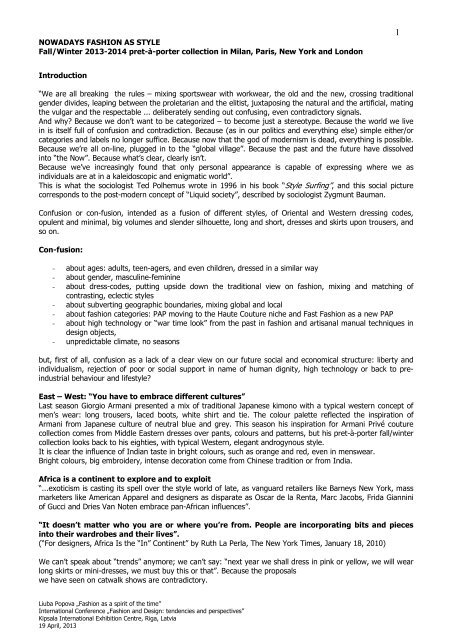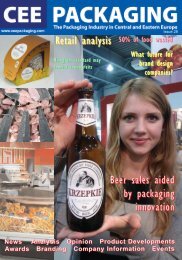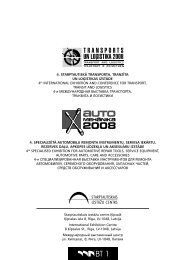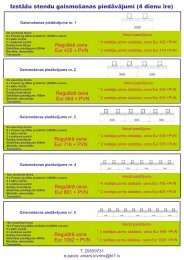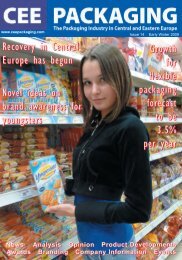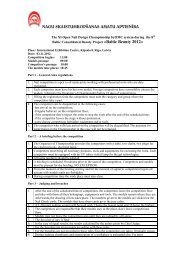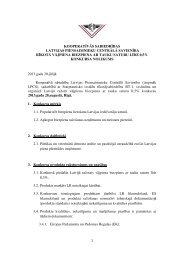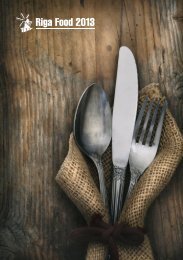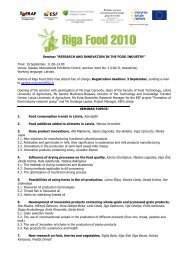Download presentation - BT 1
Download presentation - BT 1
Download presentation - BT 1
Create successful ePaper yourself
Turn your PDF publications into a flip-book with our unique Google optimized e-Paper software.
NOWADAYS FASHION AS STYLE<br />
Fall/Winter 2013-2014 pret-à-porter collection in Milan, Paris, New York and London<br />
1<br />
Introduction<br />
“We are all breaking the rules – mixing sportswear with workwear, the old and the new, crossing traditional<br />
gender divides, leaping between the proletarian and the elitist, juxtaposing the natural and the artificial, mating<br />
the vulgar and the respectable ... deliberately sending out confusing, even contradictory signals.<br />
And why Because we don’t want to be categorized – to become just a stereotype. Because the world we live<br />
in is itself full of confusion and contradiction. Because (as in our politics and everything else) simple either/or<br />
categories and labels no longer suffice. Because now that the god of modernism is dead, everything is possible.<br />
Because we’re all on-line, plugged in to the “global village”. Because the past and the future have dissolved<br />
into “the Now”. Because what’s clear, clearly isn’t.<br />
Because we’ve increasingly found that only personal appearance is capable of expressing where we as<br />
individuals are at in a kaleidoscopic and enigmatic world”.<br />
This is what the sociologist Ted Polhemus wrote in 1996 in his book “Style Surfing”, and this social picture<br />
corresponds to the post-modern concept of “Liquid society”, described by sociologist Zygmunt Bauman.<br />
Confusion or con-fusion, intended as a fusion of different styles, of Oriental and Western dressing codes,<br />
opulent and minimal, big volumes and slender silhouette, long and short, dresses and skirts upon trousers, and<br />
so on.<br />
Con-fusion:<br />
- about ages: adults, teen-agers, and even children, dressed in a similar way<br />
- about gender, masculine-feminine<br />
- about dress-codes, putting upside down the traditional view on fashion, mixing and matching of<br />
contrasting, eclectic styles<br />
- about subverting geographic boundaries, mixing global and local<br />
- about fashion categories: PAP moving to the Haute Couture niche and Fast Fashion as a new PAP<br />
- about high technology or “war time look” from the past in fashion and artisanal manual techniques in<br />
design objects,<br />
- unpredictable climate, no seasons<br />
but, first of all, confusion as a lack of a clear view on our future social and economical structure: liberty and<br />
individualism, rejection of poor or social support in name of human dignity, high technology or back to preindustrial<br />
behaviour and lifestyle<br />
East – West: “You have to embrace different cultures”<br />
Last season Giorgio Armani presented a mix of traditional Japanese kimono with a typical western concept of<br />
men’s wear: long trousers, laced boots, white shirt and tie. The colour palette reflected the inspiration of<br />
Armani from Japanese culture of neutral blue and grey. This season his inspiration for Armani Privé couture<br />
collection comes from Middle Eastern dresses over pants, colours and patterns, but his pret-à-porter fall/winter<br />
collection looks back to his eighties, with typical Western, elegant androgynous style.<br />
It is clear the influence of Indian taste in bright colours, such as orange and red, even in menswear.<br />
Bright colours, big embroidery, intense decoration come from Chinese tradition or from India.<br />
Africa is a continent to explore and to exploit<br />
“...exoticism is casting its spell over the style world of late, as vanguard retailers like Barneys New York, mass<br />
marketers like American Apparel and designers as disparate as Oscar de la Renta, Marc Jacobs, Frida Giannini<br />
of Gucci and Dries Van Noten embrace pan-African influences”.<br />
“It doesn’t matter who you are or where you’re from. People are incorporating bits and pieces<br />
into their wardrobes and their lives”.<br />
(“For designers, Africa Is the “In” Continent” by Ruth La Perla, The New York Times, January 18, 2010)<br />
We can’t speak about “trends” anymore; we can’t say: “next year we shall dress in pink or yellow, we will wear<br />
long skirts or mini-dresses, we must buy this or that”. Because the proposals<br />
we have seen on catwalk shows are contradictory.<br />
Liuba Popova „Fashion as a spirit of the time”<br />
International Conference „Fashion and Design: tendencies and perspectives”<br />
Kipsala International Exhibition Centre, Riga, Latvia<br />
19 April, 2013
What determines the styles offered by different designers and brands depends on their market, to whom<br />
they address their collections. The way of dressing always depends on lifestyle, which is very different for<br />
different countries and social classes.<br />
Economical and moral depression in Western Europe determines understatement, nostalgy about the past,<br />
research of durable materials and values, sober colours.<br />
New Oriental markets, such as BRICS countries: Brazile, Russia, India, China and South Africa, prefer showing<br />
off fashion, bright colours, big decorations, rich materials.<br />
Womenswear<br />
Bizantine opulence versus “Hospital look”<br />
Tom Ford, the maximalist: big fat embroidery even on boots, fur patchwork, bright colours. “Crosscultural/multiethnic”,<br />
Mr. Ford explaned the Chinese embroidered coats and lashings of decoration.<br />
“I’m so bored with minimalism”, said Mr. Ford. His collection is addressed to “the global universe where women<br />
have no interest in plain clothes and long to look dressed up and glamorous – as witness the excited Russian<br />
clients”.<br />
“For those who want a fashion glam-glam, Mr. Ford is their man”. (Suzy Menkes on NYT, February 19, 2013)<br />
“...at the end, Tom Ford was a victim of his own success. By the end of next year, he’l have more than 100<br />
stores around the world. You simply can’t stimulate that size of audience with the intimate, uber-controlled<br />
<strong>presentation</strong>s... You need Flash! Bang! Wallop!” (Tim Blanks, February 18, 2013, London, www.style.com).<br />
Another theme was “an ecclesiastical wardrobe” (McQueen). “The high church, nuns, popes, angels, Virgin<br />
Queen”. Calvinist culture, “sensual but severe at the same time”, Ms. Chiuri from Valentino said about<br />
ecclesiastical feel of collection inspired by Dutch Masters.<br />
Rich decoration opposite to plain fabrics<br />
The opposite to it was so called “Hospital look” presented also in London: plain fabrics, garbage bags used for<br />
pants (J. W. Anderson). The statement of intent on his program notes was: “... achieve hyper normality... the<br />
new normal... how to glorify dullness through a stringent exercise of shapes”.<br />
The current generation of “It” girls want simple, unpretentious clothes: sports-wear with a sense of fun.<br />
Sportswear or Romanticism<br />
Slender shapes, clean lines, sophisticated sportswear silhouettes in New-York: “You’ve got to be an athlete to<br />
manage in this city today”, says Mr. Michael Kors, referring to Hurricane Sandy in late October.<br />
“Sleek austerity”: leather, American look, graphic silhouette, camouflage. “No mermaid anymore”, Mr.<br />
Michael Kors said.<br />
“New Romanticism”: every critical time in our history has seen the return to the past styles. Long, slim,<br />
covered-up dresses with long sleeves. War-time style, Anna Karenina’s long coats, big skirts and narrow waist,<br />
not to expose too much flesh. Embroidery, lace, crafts, handmade.<br />
It is “Repressed romanticism”, as Mrs Prada said, “I started with a romantic idea, but I censured it. It is not<br />
a time for romantic dreaming”.<br />
The women in Milan were between melancholic and aggressive, dark, punk, with metal studs and pins,<br />
masculine fabrics, strong shoulders of jackets and coats and big boots.<br />
Global market style from Chanel represented by a gigantic globe with red flags showing the house’s<br />
international distribution. “It is the kind of fashion you can wear all over the world”, said Mr. Lagerfeld. The<br />
show was “all about fabrics”.<br />
Fabrics and handworks. A big variety of textures, especially in Milan: herryngbone tweed, prince of Wales<br />
checks, dogtooth-check; heat-bonded and overprinted to create three-dimensional texture changing with the<br />
light.<br />
Revivals: 1950s, 1960s, 1980s.<br />
Volumes: big volumes in contrast with slim silhouette, big fur coats in contrast with slender tight fitting dress<br />
Trousers: slim fit<br />
Fabrics: because of linear cut and wearable shapes of outfits the fabrics play the main role<br />
Liuba Popova „Fashion as a spirit of the time”<br />
International Conference „Fashion and Design: tendencies and perspectives”<br />
Kipsala International Exhibition Centre, Riga, Latvia<br />
19 April, 2013<br />
2
3<br />
Animal prints<br />
Digital prints: less important than in summer collections<br />
A lot of fur: foxes, shaved mink, goat, breitschwanz, astrakan, printed fur, patchwork of fur<br />
Leather, shearling<br />
No seasons: because of modern lifestyle with travelling across different continents<br />
Gender bending and androgyny: trousers suit, masculine fabrics, pinstripe, tweed.<br />
Silhouettes: slim “pencil” silhouette or big volumes, squared shoulders.<br />
Colours: dark mysterious colours, typical for the “crisis mood”, total black, black and white, grey, beige,<br />
powder, with some red and purple.<br />
Shoes: flat or high thick heels, platform sole, heavy boots with chains, lace tights.<br />
Menswear<br />
Classic three pieces grey suit: jacket, vest, trousers, versus extravagance (from British and Japanese<br />
designers) Comme des garçons thinks about adolescence, sexual confusion, innocence, uniform of urban<br />
youth. Costume National: rebels from the ‘60s; no neckties; angry young man, David Bowie felt Fedora hat and<br />
skinny Jagger pants.<br />
Dolce & Gabbana: it’s about their unique style, not fashion: real people, not models<br />
Unisex tunics, skirts for man<br />
Classic coat, similar to military cut, parka, duffle coat, trench coat<br />
Volumes: slim or big volumes, V-silhouette<br />
Fabrics: high quality wool fabrics, grey flannel or technological man-made fabrics<br />
A lot of fur, shearling, duvet<br />
Animal prints, printed big patterns (Versace), camouflage<br />
Checks, tartan<br />
Colours: a lot of grey, black, dark red, burgundy, purple, blue<br />
Leather coats, jackets, bombers<br />
Trousers: short, showing ankles, slim, with ironed pleat. High waisted, with soft pleats in front<br />
Jackets: small lapels, quiet short<br />
Vest: short, under the jacket<br />
More daywear and few evening wear, which means people are not going out night time as often as<br />
before.<br />
Shoes: heavy, big sole, ankle-boots, loafers, moonboots, metal studs, sneakers.<br />
Knitwear: strong colours, graphics, geometrical patterns<br />
Bags: backpack is back.<br />
Conclusion: “Quality is better then quantity” (Vivienne Westwood)<br />
Liuba Popova „Fashion as a spirit of the time”<br />
International Conference „Fashion and Design: tendencies and perspectives”<br />
Kipsala International Exhibition Centre, Riga, Latvia<br />
19 April, 2013
Liuba Popova „Fashion as a spirit of the time”<br />
International Conference „Fashion and Design: tendencies and perspectives”<br />
Kipsala International Exhibition Centre, Riga, Latvia<br />
19 April, 2013<br />
4
MilanoUnica Fair: Spring-Summer 2014 Directions:<br />
5<br />
Be Bold!<br />
HIGHLIGHT, MAXIMIZE, ENHANCE<br />
Transformation of matter<br />
LUXURY-GLAM and ENERGY-FUN<br />
Creative indications<br />
COLOURS<br />
Chromatic synthesis of 26 colours<br />
FOCUS on:<br />
- “Aristocratic” Haute Couture materials<br />
- Openwork, mesh, lace, crochet, cutout<br />
- “Think big” motifs in large dimensions<br />
- Extra value of handcrafted items<br />
- Accessories as creative reinforcements<br />
Liuba Popova „Fashion as a spirit of the time”<br />
International Conference „Fashion and Design: tendencies and perspectives”<br />
Kipsala International Exhibition Centre, Riga, Latvia<br />
19 April, 2013
Liuba Popova „Fashion as a spirit of the time”<br />
International Conference „Fashion and Design: tendencies and perspectives”<br />
Kipsala International Exhibition Centre, Riga, Latvia<br />
19 April, 2013<br />
6
Liuba Popova „Fashion as a spirit of the time”<br />
International Conference „Fashion and Design: tendencies and perspectives”<br />
Kipsala International Exhibition Centre, Riga, Latvia<br />
19 April, 2013<br />
7


